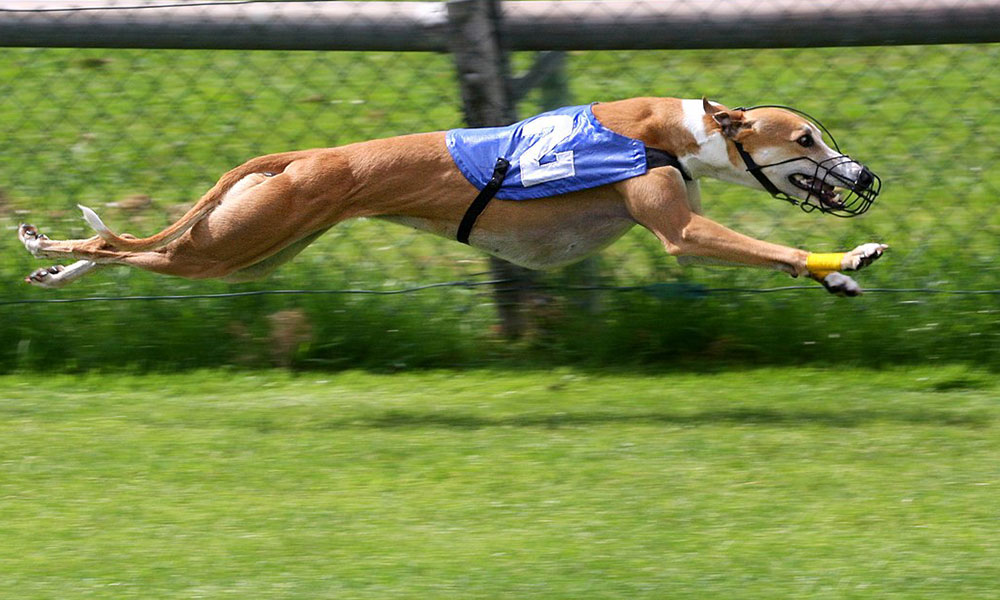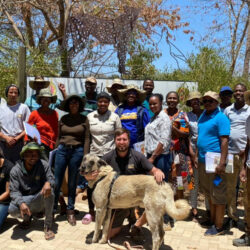Cats, Dogs and Robots Built for Speed
-

- by Meredith Hanel September 20, 2019

When it comes to speed, the cheetah reigns. Crowned the fastest land animal, the cheetah can reach 110 km per hour. The fastest dog, the greyhound, can run about 70 km per hour. To find tune their bodies for speed, cheetahs have had 8.5 million years of natural selection and dogs have only been domesticated in the last 20,000-40,000 years. While not quite as fast as cheetahs, the greyhound breed has arrived at a similar shape and size. Comparing cheetahs and greyhounds has allowed scientists to pinpoint special characteristics that impart extra speed to the cheetah. Now engineers are borrowing from the cheetah’s speed tweaked body design to build robots that are fast and agile.
Cheetah versus Greyhound
The cheetah’s bone lengths and musculature support longer strides. Forelimbs and hindlimbs of cheetahs are proportionally longer than the greyhound. The large digital flexors and extensors on cheetah forelimbs are thought to help them dig their toes into the ground for traction. The cheetah’s effective stride is thought to be further lengthened by a muscle behind the shoulders that is longer in cheetahs compared with greyhounds. The forearms of cheetahs have been shown to have muscles with large physiological cross-sectional area, likely enabling them to resist the force coming back from the ground.


Cheetahs using fewer and longer strides than greyhounds have been shown in video. In 2012 scientists filmed cheetahs from a zoo in England and a cheetah center in South Africa and greyhounds that had retired from racing careers. The animals were filmed with high-speed cameras running along a 100-yard track chasing a mechanical lure. Some animals ran across a force plate which showed that cheetahs put more weight on their hind limbs than greyhounds, which could help them grip the ground and have better acceleration and maneuvering while freeing their forelimbs to capture prey. Unfortunately, this study failed to catch cheetahs running near top speed—the greyhounds outran them, likely because these zoo cheetahs had never learned to run and catch prey.
In 2018, sprinting cheetahs and greyhounds were compared by another group of researchers, but this time they had the animals run in straight lines and on curves using a 400 metre track and a lure. They found that cheetahs and greyhound showed differences in running curves. The measurement known as duty time measures the relative time allotted for re-accelerating and redirecting the centre of mass of the body when changing direction. In greyhounds running on curves three out of the four limbs showed increased duty, the non-lead and lead forelimbs and the lead hind limb. But cheetahs showed increased duty only for the non-lead hind limb, leaving the other three limbs for maintaining speed.
Cheetah Robots
Cheetah anatomy has provided inspiration for engineering agile robots that can run fast. A cheetah robot designed by MIT researchers can run and jump obstacles in its path. In bio-inspired robotics, researchers don’t always want to imitate animals exactly but rather use robotics to understand how animals do something well and then apply those principles to further designs. In the cheetah robot, the spine, shoulders and hips match the position in real cheetahs and a spring is used in the robot cheetah to imitate the way cheetahs bend and extend their spine. The initial version of the robotic cheetah was able to run up to 13 mph (21 kph) which is less than a quarter the speed of a real cheetah but it is more energy efficient than a real cheetah. Another robotic cheetah made by Boston Dynamics that cannot jump over obstacles reached 28.3 mph (45.5 kph), which is faster than world record sprinter Usain Bolt.
Cheetah-like robots that are fast, agile and energy efficient could one day be used in emergency rescue scenarios to search for people after a disaster. Scientists can also use cheetah robots to model and test hypotheses about cheetah locomotion that can’t be done in real cheetahs.
References
“12 Of the Fastest Dog Breeds.” Canadian Running Magazine, 28 Aug. 2017, /.
Chu, Jennifer, and MIT News Office. “Mini Cheetah Is the First Four-Legged Robot to Do a Backflip.” MIT News, 4 Mar. 2019, .
Glaser, April. “Robots Copy Their Coolest Moves from Animals.” Vox, Vox, 28 May 2017.
Gugliotta, Guy. “Rare Breed.” Smithsonian.com, Smithsonian Institution, 1 Mar. 2008.
Heater, Brian. “MIT’s Cheetah 3 Robot Is Built to Save Lives.” TechCrunch, TechCrunch, 17 July 2017.
Hudson, P. E., et al. “High Speed Galloping in the Cheetah (Acinonyx Jubatus) and the Racing Greyhound (Canis Familiaris): Spatio-Temporal and Kinetic Characteristics.” Journal of Experimental Biology, vol. 215, no. 14, 2012, pp. 2425–2434., doi:10.1242/jeb.066720.
Hudson, Penny E., et al. “Functional Anatomy of the Cheetah (Acinonyx Jubatus) Forelimb.” Journal of Anatomy, vol. 218, no. 4, 2011, pp. 375–385., doi:10.1111/j.1469-7580.2011.01344.x.
Hudson, Penny E., et al. “Functional Anatomy of the Cheetah (Acinonyx Jubatus) Hindlimb.” Journal of Anatomy, vol. 218, no. 4, 2010, pp. 363–374., doi:10.1111/j.1469-7580.2010.01310.x.
Ichikawa, Hiroshi, et al. “Gait Characteristics of Cheetahs (Acinonyx Jubatus) and Greyhounds (Canis Lupus Familiaris) Running on Curves.” Mammal Study, vol. 43, no. 3, 2018, pp. 199–206., doi:10.3106/ms2017-0089.
Kratochwill, Lindsey. “Robot Cheetah.” Robot Cheetah | Popular Science, Popular Science, 18 Mar. 2019.
Lallensack, Racheal. “Ancient Genomes Heat up Dog Domestication Debate.” Nature News, Nature Publishing Group, 18 July 2017.
Orwig, Jessica. “MIT’s Super-Stealthy Robot Cheetah Can Run You Down.” Business Insider, Business Insider, 16 Sept. 2014.
“Robo-Cheetah Can Outrun Usain Bolt.” NBCNews.com, NBCUniversal News Group, 5 Sept. 2012.
“Robotic Cheetah Created.” ScienceDaily, ScienceDaily, 19 Apr. 2017.
Taylor, Jordyn. “MIT’s New Robot Cheetah Is a Better Cheetah Than Real Cheetahs.” Observer, Observer, 18 June 2013.
Zielinski, Sarah. “What Give Cheetahs The Edge In a Race With Greyhounds.” Smithsonian.com, Smithsonian Institution, 25 June 2012.
Related Reading
-
November 9, 2023
Giving Tuesday Canada 2023 – Supporting Namibian Youth



